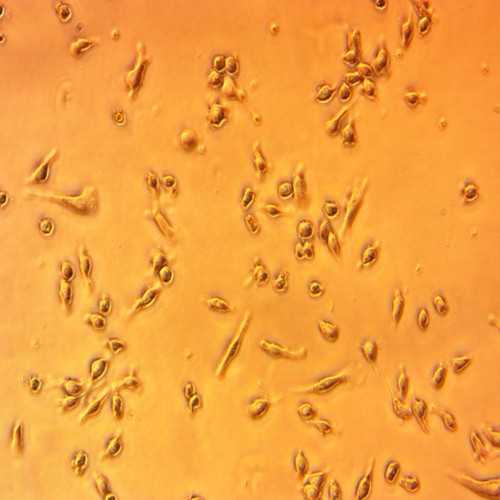Microglial Cell Line (IMG)
Immortalized microglial cell line (IMG) isolated from the brains of adult mice.
Highlights:
- Express the markers F4/80 and CD11b but not the neuronal marker NeuN or the astrocyte marker GFAP
- Display a robust response (M1/M2 polarization) to inflammatory signals and can therefore be used to examine mechanisms of drug action and drug efficacy in regards to M1/M2 polarization
- Can be induced to pro- or anti-inflammatory microglial phenotypes
- Able to phagocytose foreign particles and misfolded proteins such as amyloid-beta peptide
Microglia cells share functional similarities with macrophages, and are thought to act as the primary immune cells of the central nervous system (CNS). They monitor their microenviornment and become activated upon detection of abnormal and/or offensive signals. Activated microglia have been found in inflammatory conditions such as brain/spinal cord injury, ischemic strokes, infections and neurodegenerative diseases. Recent findings indicate that microglia are also involved in learning and memory by regulating synaptic plasticity.
From the laboratory of Chih-Hao Lee, PhD, Harvard University.
Immortalized microglial cell line (IMG) isolated from the brains of adult mice.
Highlights:
- Express the markers F4/80 and CD11b but not the neuronal marker NeuN or the astrocyte marker GFAP
- Display a robust response (M1/M2 polarization) to inflammatory signals and can therefore be used to examine mechanisms of drug action and drug efficacy in regards to M1/M2 polarization
- Can be induced to pro- or anti-inflammatory microglial phenotypes
- Able to phagocytose foreign particles and misfolded proteins such as amyloid-beta peptide
Microglia cells share functional similarities with macrophages, and are thought to act as the primary immune cells of the central nervous system (CNS). They monitor their microenviornment and become activated upon detection of abnormal and/or offensive signals. Activated microglia have been found in inflammatory conditions such as brain/spinal cord injury, ischemic strokes, infections and neurodegenerative diseases. Recent findings indicate that microglia are also involved in learning and memory by regulating synaptic plasticity.
From the laboratory of Chih-Hao Lee, PhD, Harvard University.
| Product Type: | Cell Line |
| Name: | Immortalized Microglial Cell (IMG) |
| Cell Type: | Immortalized microglial cell |
| Accession ID: | CVCL_HC49 |
| Morphology: | Ramified/Amoeboid |
| Source: | Brain |
| Organism: | Mouse (8-wk-old C57BL/6J) |
| Biosafety Level: | BSL2 |
| Growth Conditions: | DMEM with 4.5g/L glucose with glutamate, 10% FBS, 1% Penicillin/Streptomycin |
| Cryopreservation: | Growth Medium + 10% DMSO |
| Storage: | Liquid nitrogen |
| Shipped: | Dry ice |
- McCarthy RC, Lu DY, Alkhateeb A, Gardeck AM, Lee CH, Wessling-Resnick M. Characterization of a novel adult murine immortalized microglial cell line and its activation by amyloid-beta. J Neuroinflammation. 2016 Jan 27;13(1):21. doi: 10.1186/s12974-016-0484-z. PubMed PMID: 26819091.
- Castro-Sánchez S, García-Yagüe ÁJ, Kügler S, Lastres-Becker I. CX3CR1-deficient microglia shows impaired signalling of the transcription factor NRF2: Implications in tauopathies. Redox Biol. 2019 Apr;22:101118. View Article
- Galán-Ganga M, García-Yagüe ÁJ, Lastres-Becker I. Role of MSK1 in the Induction of NF-κB by the Chemokine CX3CL1 in Microglial Cells. Cell Mol Neurobiol. 2019 Apr;39(3):331-340. View Article
- Tom S, Rane A, Katewa AS, Chamoli M, Matsumoto RR, Andersen JK, Chinta SJ. Gedunin Inhibits Oligomeric Aβ(1-42)-Induced Microglia Activation Via Modulation of Nrf2-NF-κB Signaling. Mol Neurobiol. 2019 May 24. View Article
- Li Y, Glotfelty EJ, Karlsson T, Fortuno LV, Harvey BK, Greig NH. The metabolite GLP-1 (9-36) is neuroprotective and anti-inflammatory in cellular models of neurodegeneration. J Neurochem. 2021 Dec;159(5):867-886. doi: 10.1111/jnc.15521. Epub 2021 Oct 21. PMID: 34569615; PMCID: PMC8627453.
- Viil J, Somelar-Duracz K, Jaako K, Anier K, Zharkovsky A. Characterization of IMG Microglial Cell Line as a Valuable In Vitro Tool for NLRP3 Inflammasome Studies. Cell Mol Neurobiol. 2022 Sep 26. doi: 10.1007/s10571-022-01285-6. Epub ahead of print. PMID: 36163404.
If you publish research with this product, please let us know so we can cite your paper.


